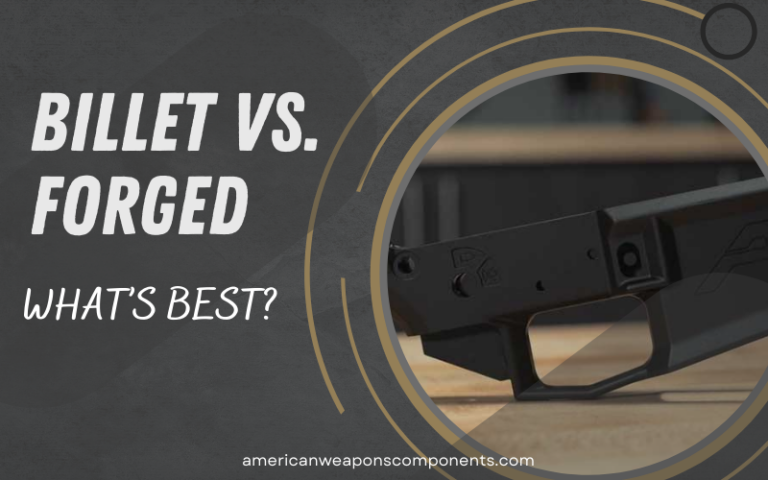AWC offers a variety of Billet and Forged 80% AR-15 lowers, which should you choose? There’s plenty of lively discussion about the pros and cons of each. Why the difference in price? Which is strongest? Which is lightest?
What grade of aluminum should you look for? The discussion and debate seems to never end. This short article should help clean up some of the discussion and allow you as a customer make a more informed decision on an AWC AR-15 lower receiver.
Forged Versus Billet Lowers on the AR-15 Platform

Forged ANO AR15 80% Lower
Manufacturing Processes
There are multiple ways to manufacture a lower but the most commonly discussed are forged AR-15 lowers and billet AR-15 lowers. 7075-grade aluminum is used for all AWC 80% lower receivers.
Forgings are made by hammering together two roughly shaped halves of hot aluminum and cleaning up the profile with machines later. This allows for minimal machining, keeping cost of production low, and overall a more affordable lower.
Billet AR-15 lowers are made by taking a single block of aluminum and having a CNC machine mill out the profile of a lower. This process takes longer, as the CNC machine mills an entire block of aluminum into shape, as opposed to starting with the rough shape in place.
Billet lower manufacturing also allows for more unique designs and integrated features to be achieved.

Billet ANO AR15 80% Lower
Material Quality
There are two main grades of aluminum used for AR-15 parts, 6061 and 7075. These numbers are used to grade and specify what type of aluminum alloy manufacturers are working with.
There is also often a subgrade added to the end of the alloy number, “-T4” or “-T6,” for example. These numbers measure the temper placed on the aluminum, meaning how metallurgists heat treat the metal to give it different properties other than what is found in the base alloy.
6061-T6 and 7075-T6 are two of the most common aluminum alloys around in AR-15 lower receiver use. While 6061 aluminum is a very useful and serviceable alloy, it is not as rugged as 7075-grade aluminum, especially when tempered to the “-T6” designation.
AWC’s AR-15 80% lower receivers are made from 7075-T6 aluminum alloy, the highest possible quality material selected for end users to own.
Functionality
In terms of strict function, there are operationally no differences between a forged 80% AR-15 lower and a billet 80% AR-15 lower when finished to proper specification. The main differences are aesthetic; forged lowers from any company will match dimensionally, both internally and externally.
The vast majority of forged lowers are made to the latest military specifications. Forged lowers follow those specifications in order to give customers the classic look and feel of a traditional AR-15/M-16, keeping it simple for those who want a straightforward, battle proven design.
Billet lowers allow more artistic leeway with manufacturers. Straighter edges, 90-degree angles, designs/decorations, and variations in magazine well sizing, to name a few things that can be done with billet lowers.
AR-15 lowers come with clean lines, straighter edges, and an integrated, enlarged trigger guard. AWC Signature III% AR-15 80% lower series offer even more than that: Beefier aesthetics, a flared magazine well, the III% logo on the front milled into the aluminum, all of which offer a more unique styling.
Durability
Durability might be the most hotly debated part of the forged lower vs. billet lower discussion. General consensus tends to be that due to the nature of the forging process that forged lowers are technically more durable.
The pressure applied by the hammering of forging compresses the aluminum and makes the metal grain run in a homogenous direction; both good things for rigidity and durability. Forged lowers tend to be lighter than billet lowers, as they generally don’t have as much extra material from proprietary design differences.
Billet lowers do not have those hammer-hardened characteristics, but with the use of high quality 7075-grade aluminum in this day and age any concerns about durability are largely unnecessary.
It then ends up, as most things AR-15 will, as a personal preference choice from the end user.
In Summary
There are many things to think about when purchasing an AWC AR-15 lower receiver, hopefully this brief breakdown of the differences between forged and billet AR-15 receivers can help you make a more informed decision.
AWC strives to make the highest quality lowers, parts, and accessories, so buy with confidence knowing you’re getting the highest possible quality of gear. So which should you buy? Only you can make that decision. Stay safe and happy building.

